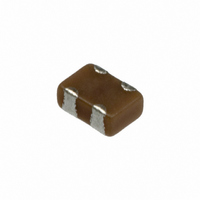Multilayer Ceramic Capacitors
Series:
■ Operating Conditions and Circuit Design
1. Circuit Design
Design and specifi cations are each subject to change without notice. Ask factory for the current technical specifi cations before purchase and/or use.
Should a safety concern arise regarding this product, please be sure to contact us immediately.
1.1 Operating Temperature and Storage Temperature
1.2 Design of Voltage Application
1.3 Charging and Discharging Current
Multilayer Ceramic Chip Capacitors (hereafter referred to as “Capacitors”) should be used for general purpose
applications found in consumer electronics (audio/visual, home, offi ce, information & communication) equipment.
When subjected to severe electrical, environmental, and/or mechanical stress beyond the specifi cations, as noted
in the Ratings and Specifi ed Conditions section, the capacitor may fail in a short circuit mode or in an open-circuit
mode. This case results in a burn-out, smoke or fl aming.
For products which require high safety levels, please carefully consider how a single malfunction can affect your
product. In order to ensure the safety in the case of a single malfunction, please design products with fail-safe,
such as setting up protecting circuits, etc.
● For the following applications and conditions, please contact us for additional specifi cations not found in this document.
The specifi ed “Operating Temperature Range” found
in the specifi cations is the absolute maximum and
minimum temperature rating. Every Capacitor shall be
operated within the specifi ed “Operating Temperature
Range”.
The capacitors mounted on PCB shall be stored
without operating within the specified “ Storage
Temperature Range” in the Specifications.
Capacitors shall not be operated in excess of the
specifi ed “Rated Voltage” in the Specifi cation.
If voltage ratings are exceeded, the Capacitors could
result in failure or damage. The designed peak DC and
AC voltages applied to the Capacitors, shall be within
the specifi ed “Rated Voltage”.
In case of AC of pulse voltage, the peak voltage shall
be within the specifi ed “Rated Voltage”. If high frequency
voltage or fast rising pulse voltages are continuously
applied, even when within the “Rated Voltage”, consider
that the reliability of the Capacitor may change. Continuous
application of those types of voltages can affects the life of
the Capacitors.
The Capacitors shall not be operated beyond the specifi ed
“Maximum Charging/Discharging Current Ratings” in
the specifi cations. For safety reasons Panasonic does
not recommend use in applications with low impedance
circuitry such as “secondary power circuits”.
Safety Precautions
1 Aircraft and Aerospace Equipment (artifi cial satellite, rocket, etc.)
2 Submarine Equipment (submarine repeating equipment, etc.)
3 Transportation Equipment (motor vehicles, airplanes, trains, ship, traffi c signal controllers, etc.)
4 Power Generation Control Equipment (atomic power, hydroelectric power, thermal power plant control system, etc.)
5 Medical Equipment (life-support equipment, pacemakers, dialysis controllers, etc.)
6 Information Processing Equipment (large scale computer systems, etc.)
7 Electric Heating Appliances, Combustion devices (gas fan heaters, oil fan heaters, etc.)
8 Rotary Motion Equipment
9 Security Systems
J And any similar types of equipment
· When your application may have diffi culty complying with the safety or handling precautions specifi ed below.
· For any applications where a malfunction with this product may directly or indirectly cause hazardous
conditions which could result in death or injury;
ECJ, ECY, ECD
Handling Precautions
– EC48 –
1.4 Temperature Rise due to Dielectric Loss of
1.5 Environmental Restrictions
1.6 DC Voltage Characteristics
The “Operating Temperature Range” mentioned above
shall include a maximum surface temperature rise of
20 °C, which is caused by the Dielectric loss of the
Capacitor and applied electrical stresses such as
voltage, frequency and wave form. It is recommended
to measure and check the “Surface Temperature of the
Capacitor” in the application at room temperature (up
to 25 °C).
The Capacitors shall not be operated and/or stored
under the following conditions.
(1) Environmental conditions
(2) Mechanical conditions
The Capacitors (Class 2) employ dielectric ceramics with
dielectric constant having voltage dependency, and if
the applied DC voltage is high, capacitance may broadly
change. For the specifi ed capacitance, the following
should be confi rmed.
the Capacitors
(a) Under direct exposure to water or salt water
(b) Under conditions where water can condense
(c) Under conditions containing corrosive gases
Under severe conditions of vibration or impact beyond
the specifi ed conditions found in the Specifi cations
and/or dew can form
such as hydrogen sulfi de, sulfurous acid, chlorine
and ammonia
Multilayer Ceramic Capacitors
00 Sep. 2008
















